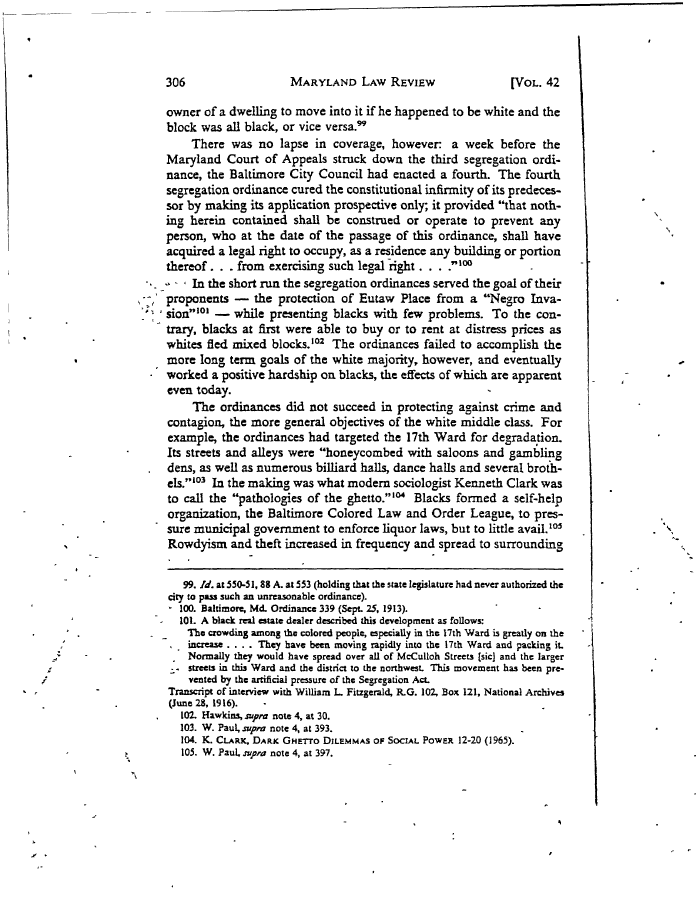 |
||||
|
Garrett Power, Apartheid Baltimore Style: The Residential Segregation Ordinances of 1910-1913, Maryland Law Review, 42 (1983) , Image No: 19 Enlarge and print image (62K) << PREVIOUS NEXT >> |
 |
||||
|
Garrett Power, Apartheid Baltimore Style: The Residential Segregation Ordinances of 1910-1913, Maryland Law Review, 42 (1983) , Image No: 19 Enlarge and print image (62K) << PREVIOUS NEXT >> |
| 306 MARYLAND LAW REVIEW [VOL. 42 owner of a dwelling to move into it if he happened to be white and the block was all black, or vice versa.99 There was no lapse in coverage, however a week before the Maryland Court of Appeals struck down the third segregation ordi- nance, the Baltimore City Council had enacted a fourth. The fourth segregation ordinance cured the constitutional infirmity of its predeces- sor by making its application prospective only; it provided "that noth- ing herein contained shall be construed or operate to prevent any person, who at the date of the passage of this ordinance, shall have acquired a legal right to occupy, as a residence any building or portion thereof. . . . from exercising such legal right. . . .100 In the short run the segregation ordinances served the goal of their proponents — the protection of Eutaw Place from a "Negro Inva- sion"101 — while presenting blacks with few problems. To the con- trary, blacks at first were able to buy or to rent at distress prices as whites fled mixed blocks.102 The ordinances failed to accomplish the more long term goals of the white majority, however, and eventually worked a positive hardship on blacks, the effects of which are apparent even today. The ordinances did not succeed in protecting against crime and contagion, the more general objectives of the white middle class. For example, the ordinances had targeted the 17th Ward for degradation. Its streets and alleys were "honeycombed with saloons and gambling dens, as well as numerous billiard halls, dance halls and several broth- els.103 In the making was what modern sociologist Kenneth Clark was to call the "pathologies of the ghetto."104 Blacks formed a self-help organization, the Baltimore Colored Law and Order League, to pres- sure municipal government to enforce liquor laws, but to little avail.103 Rowdyism and theft increased in frequency and spread to surrounding 99. Id. at 550-51,88 A. at 253 (holding that the state legislature had never authorized the city to pass such an unreasonable ordinance). 100. Baltimore, Md. Ordinance 339 (Sept. 25, 1913). 101. A black real estate dealer described this development as follows: The crowding among the colored people, especially in the 17th Ward is greatly on the increase .... They have been moving rapidly into the 17th Ward and packing it Normally they would have spread over all of McCulloh Streets [sic] and the larger streets in this Ward and the district to the northwest This movement has been pre- vented by the artificial pressure of the Segregation Act Transcript of interview with William L. Fitzgerald, R.G. 102, Box 121, National Archives (June 28, 1916). 102. Hawkins, supra note 4, at 30. 103. W. Paul, supra note 4, at 393. 104. K. CLARK, DARK GHETTO DILEMMAS OF SOCIAL POWER 12-20 (1965). 105. W. Paul supra note 4, at 397. |